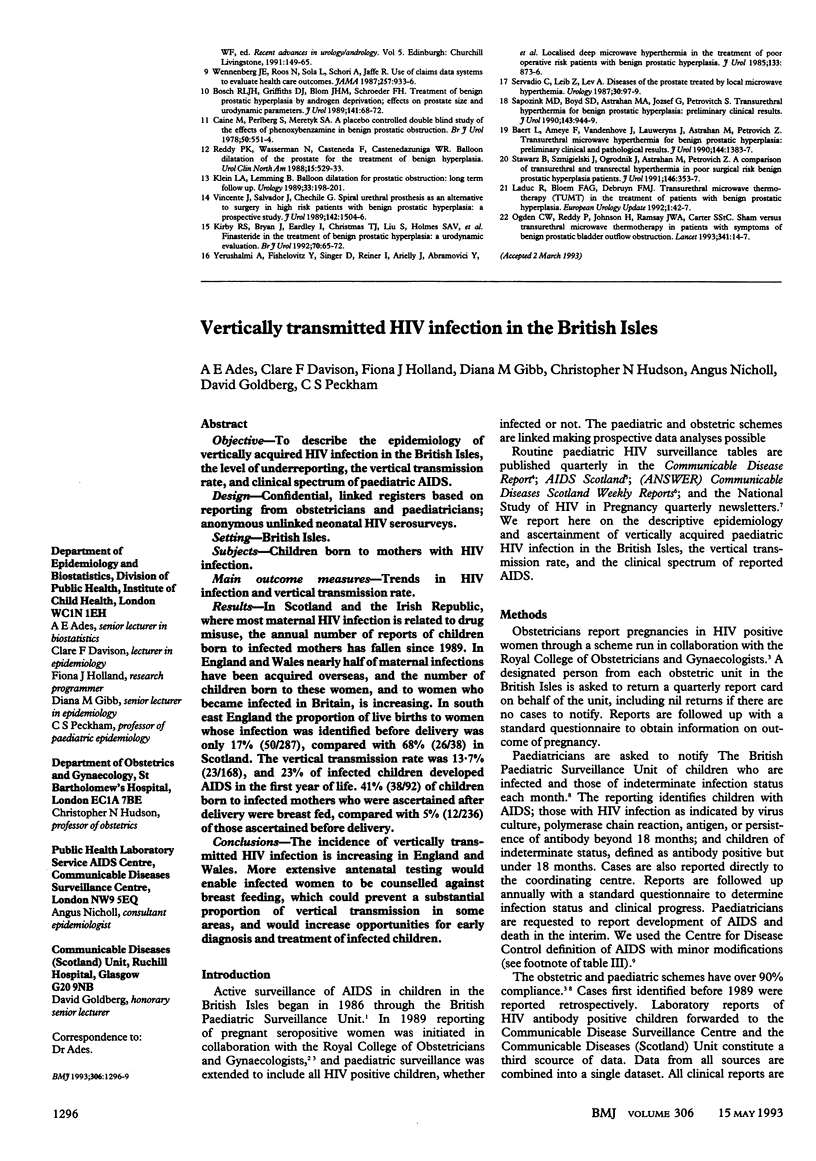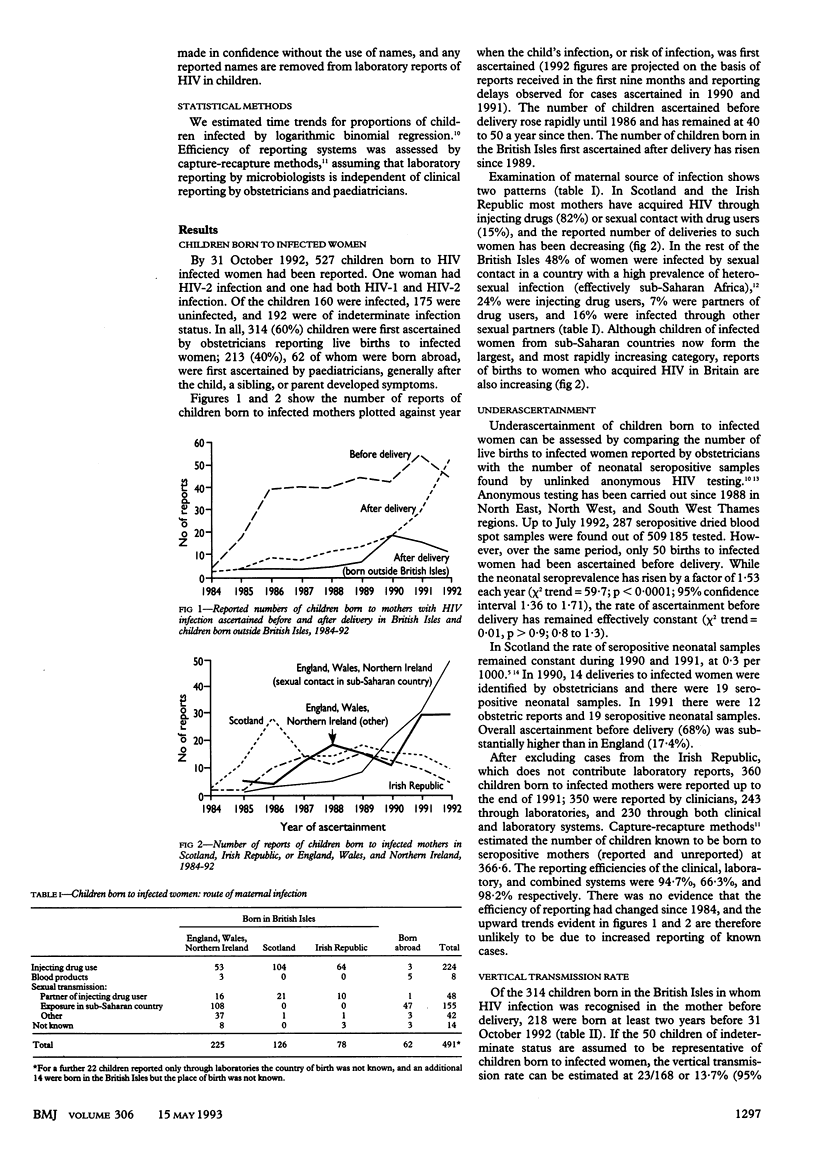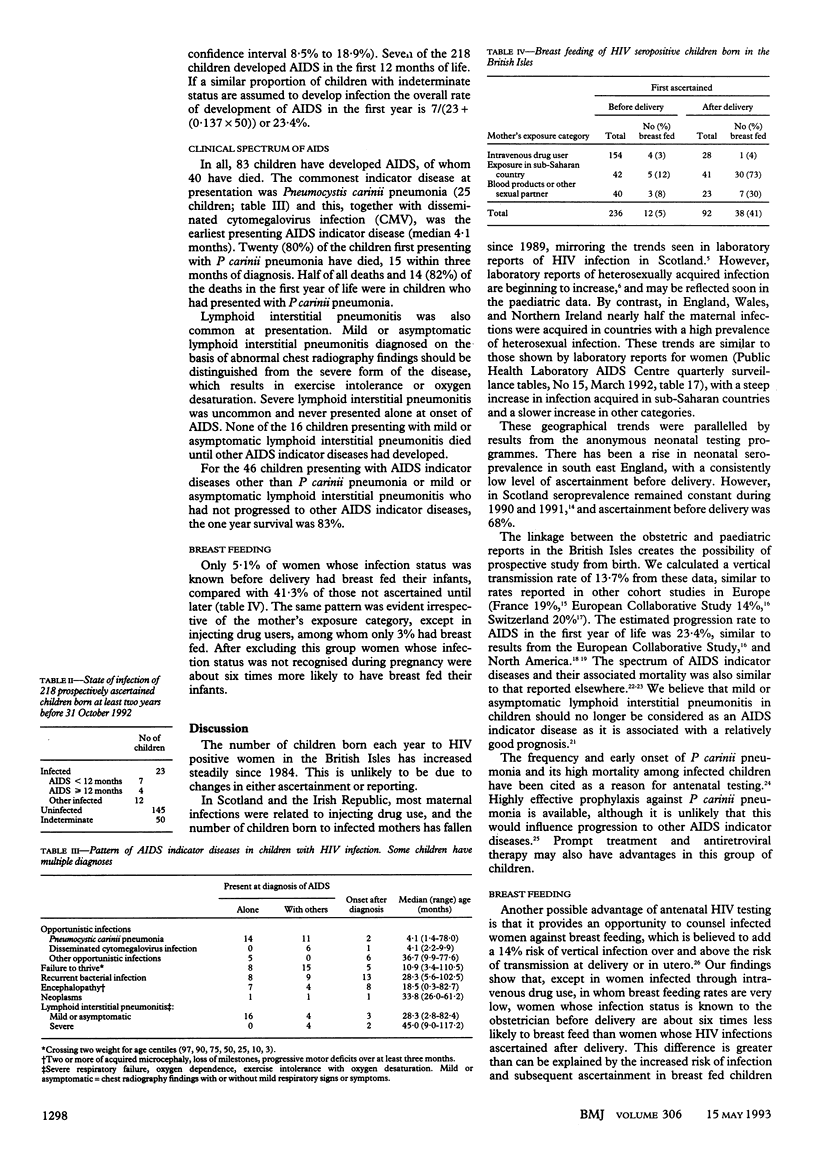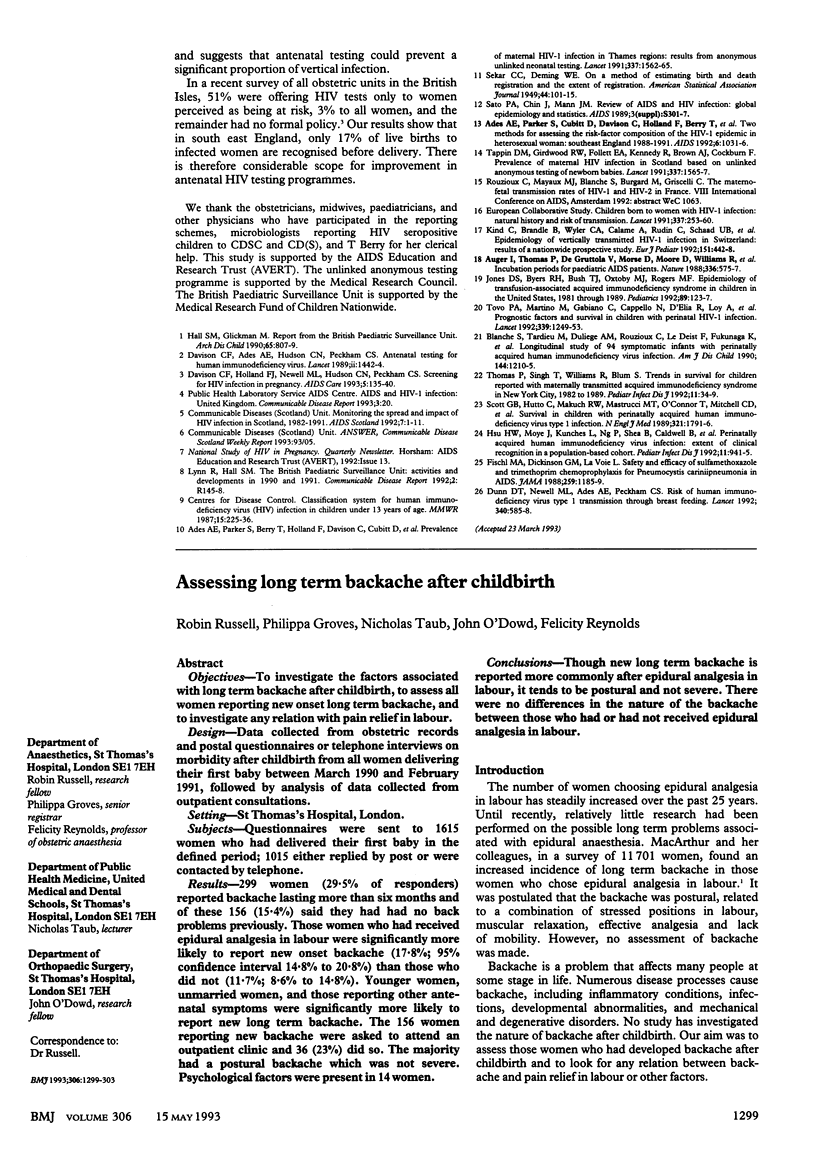Abstract
OBJECTIVE--To describe the epidemiology of vertically acquired HIV infection in the British Isles, the level of underreporting, the vertical transmission rate, and clinical spectrum of paediatric AIDS. DESIGN--Confidential, linked registers based on reporting from obstetricians and paediatricians; anonymous unlinked neonatal HIV serosurveys. SETTING--British Isles. SUBJECTS--Children born to mothers with HIV infection. MAIN OUTCOME MEASURES--Trends in HIV infection and vertical transmission rate. RESULTS--In Scotland and the Irish Republic, where most maternal HIV infection is related to drug misuse, the annual number of reports of children born to infected mothers has fallen since 1989. In England and Wales nearly half of maternal infections have been acquired overseas, and the number of children born to these women, and to women who became infected in Britain, is increasing. In south east England the proportion of live births to women whose infection was identified before delivery was only 17% (50/287), compared with 68% (26/38) in Scotland. The vertical transmission rate was 13.7% (23/168), and 23% of infected children developed AIDS in the first year of life. 41% (38/92) of children born to infected mothers who were ascertained after delivery were breast fed, compared with 5% (12/236) of those ascertained before delivery. CONCLUSIONS--The incidence of vertically transmitted HIV infection is increasing in England and Wales. More extensive antenatal testing would enable infected women to be counselled against breast feeding, which could prevent a substantial proportion of vertical transmission in some areas, and would increase opportunities for early diagnosis and treatment of infected children.
Full text
PDF



Selected References
These references are in PubMed. This may not be the complete list of references from this article.
- Ades A. E., Parker S., Berry T., Holland F. J., Davison C. F., Cubitt D., Hjelm M., Wilcox A. H., Hudson C. N., Briggs M. Prevalence of maternal HIV-1 infection in Thames regions: results from anonymous unlinked neonatal testing. Lancet. 1991 Jun 29;337(8757):1562–1565. doi: 10.1016/0140-6736(91)93260-g. [DOI] [PubMed] [Google Scholar]
- Ades A. E., Parker S., Cubitt D., Davison C., Holland F., Berry T., Hjelm M., Wilcox A. H., Peckham C. S. Two methods for assessing the risk-factor composition of the HIV-1 epidemic in heterosexual women: southeast England, 1988-1991. AIDS. 1992 Sep;6(9):1031–1036. doi: 10.1097/00002030-199209000-00018. [DOI] [PubMed] [Google Scholar]
- Auger I., Thomas P., De Gruttola V., Morse D., Moore D., Williams R., Truman B., Lawrence C. E. Incubation periods for paediatric AIDS patients. Nature. 1988 Dec 8;336(6199):575–577. doi: 10.1038/336575a0. [DOI] [PubMed] [Google Scholar]
- Blanche S., Tardieu M., Duliege A., Rouzioux C., Le Deist F., Fukunaga K., Caniglia M., Jacomet C., Messiah A., Griscelli C. Longitudinal study of 94 symptomatic infants with perinatally acquired human immunodeficiency virus infection. Evidence for a bimodal expression of clinical and biological symptoms. Am J Dis Child. 1990 Nov;144(11):1210–1215. doi: 10.1001/archpedi.1990.02150350042021. [DOI] [PubMed] [Google Scholar]
- Davison C. F., Ades A. E., Hudson C. N., Peckham C. S. Antenatal testing for human immunodeficiency virus. Results from the Royal College of Obstetricians and Gynaecologists' National Study of HIV Infection in Pregnancy. Lancet. 1989 Dec 16;2(8677):1442–1444. doi: 10.1016/s0140-6736(89)92045-x. [DOI] [PubMed] [Google Scholar]
- Davison C. F., Holland F. J., Newell M. L., Hudson C. N., Peckham C. S. Screening for HIV infection in pregnancy. AIDS Care. 1993;5(2):135–140. doi: 10.1080/09540129308258593. [DOI] [PubMed] [Google Scholar]
- Dunn D. T., Newell M. L., Ades A. E., Peckham C. S. Risk of human immunodeficiency virus type 1 transmission through breastfeeding. Lancet. 1992 Sep 5;340(8819):585–588. doi: 10.1016/0140-6736(92)92115-v. [DOI] [PubMed] [Google Scholar]
- Fischl M. A., Dickinson G. M., La Voie L. Safety and efficacy of sulfamethoxazole and trimethoprim chemoprophylaxis for Pneumocystis carinii pneumonia in AIDS. JAMA. 1988 Feb 26;259(8):1185–1189. doi: 10.1001/jama.259.8.1185. [DOI] [PubMed] [Google Scholar]
- Hall S. M., Glickman M. Report from the British Paediatric Surveillance Unit. Arch Dis Child. 1990 Jul;65(7):807–809. doi: 10.1136/adc.65.7.807. [DOI] [PMC free article] [PubMed] [Google Scholar]
- Hsu H. W., Moye J., Jr, Kunches L., Ng P., Shea B., Caldwell B., Demaria A., Mofenson L., Grady G. F. Perinatally acquired human immunodeficiency virus infection: extent of clinical recognition in a population-based cohort. Massachusetts Pediatric HIV Surveillance Working Group. Pediatr Infect Dis J. 1992 Nov;11(11):941–945. [PubMed] [Google Scholar]
- Jones D. S., Byers R. H., Bush T. J., Oxtoby M. J., Rogers M. F. Epidemiology of transfusion-associated acquired immunodeficiency syndrome in children in the United States, 1981 through 1989. Pediatrics. 1992 Jan;89(1):123–127. [PubMed] [Google Scholar]
- Kind C., Brändle B., Wyler C. A., Calame A., Rudin C., Schaad U. B., Schüpbach J., Senn H. P., Perrin L., Matter L. Epidemiology of vertically transmitted HIV-1 infection in Switzerland: results of a nationwide prospective study. Swiss Neonatal HIV Study Group. Eur J Pediatr. 1992 Jun;151(6):442–448. doi: 10.1007/BF01959360. [DOI] [PubMed] [Google Scholar]
- Lynn R., Hall S. M. The British Paediatric Surveillance Unit: activities and developments in 1990 and 1991. Commun Dis Rep CDR Rev. 1992 Dec 4;2(13):R145–R148. [PubMed] [Google Scholar]
- Sato P. A., Chin J., Mann J. M. Review of AIDS and HIV infection: global epidemiology and statistics. AIDS. 1989;3 (Suppl 1):S301–S307. doi: 10.1097/00002030-198901001-00043. [DOI] [PubMed] [Google Scholar]
- Scott G. B., Hutto C., Makuch R. W., Mastrucci M. T., O'Connor T., Mitchell C. D., Trapido E. J., Parks W. P. Survival in children with perinatally acquired human immunodeficiency virus type 1 infection. N Engl J Med. 1989 Dec 28;321(26):1791–1796. doi: 10.1056/NEJM198912283212604. [DOI] [PubMed] [Google Scholar]
- Tappin D. M., Girdwood R. W., Follett E. A., Kennedy R., Brown A. J., Cockburn F. Prevalence of maternal HIV infection in Scotland based on unlinked anonymous testing of newborn babies. Lancet. 1991 Jun 29;337(8757):1565–1567. doi: 10.1016/0140-6736(91)93261-7. [DOI] [PubMed] [Google Scholar]
- Thomas P., Singh T., Williams R., Blum S. Trends in survival for children reported with maternally transmitted acquired immunodeficiency syndrome in New York City, 1982 to 1989. Pediatr Infect Dis J. 1992 Jan;11(1):34–39. doi: 10.1097/00006454-199201000-00009. [DOI] [PubMed] [Google Scholar]
- Tovo P. A., de Martino M., Gabiano C., Cappello N., D'Elia R., Loy A., Plebani A., Zuccotti G. V., Dallacasa P., Ferraris G. Prognostic factors and survival in children with perinatal HIV-1 infection. The Italian Register for HIV Infections in Children. Lancet. 1992 May 23;339(8804):1249–1253. doi: 10.1016/0140-6736(92)91592-v. [DOI] [PubMed] [Google Scholar]


